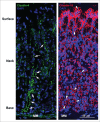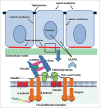Non-canonical functions of claudin proteins: Beyond the regulation of cell-cell adhesions
- PMID: 28548895
- PMCID: PMC5501131
- DOI: 10.1080/21688370.2017.1327839
Non-canonical functions of claudin proteins: Beyond the regulation of cell-cell adhesions
Abstract
Tight junctions form a barrier to the diffusion of apical and basolateral membrane proteins thus regulating membrane polarity. They also regulate the paracellular movement of ions and water across epithelial and endothelial cells so that functionally they constitute an important permselective barrier. Permselectivity at tight junctions is regulated by claudins, which confer anion or cation permeability, and tightness or leakiness, by forming several highly regulated pores within the apical tight junction complex. One interesting feature of claudins is that they are, more often than not, localized to the basolateral membrane, in intracellular cytoplasmic vesicles, or in the nucleus rather than to the apical tight junction complex. These intracellular pools of claudin molecules likely serve important functions in the epithelium. This review will address the widespread prevalence of claudins that are not associated with the apical tight junction complex and discuss the important and emerging non-traditional functions of these molecules in health and disease.
Keywords: EMT; claudin; nuclear transcription; review.
Figures



Similar articles
-
[Claudins as tight junction proteins: the molecular element of paracellular transport].Ross Fiziol Zh Im I M Sechenova. 2013 Feb;99(2):175-95. Ross Fiziol Zh Im I M Sechenova. 2013. PMID: 23650732 Review. Russian.
-
Developmental Expression of Claudins in the Mammary Gland.J Mammary Gland Biol Neoplasia. 2017 Jun;22(2):141-157. doi: 10.1007/s10911-017-9379-6. Epub 2017 Apr 28. J Mammary Gland Biol Neoplasia. 2017. PMID: 28455726 Free PMC article.
-
Paracellular barrier and channel functions of TJ claudins in organizing biological systems: advances in the field of barriology revealed in knockout mice.Semin Cell Dev Biol. 2014 Dec;36:177-85. doi: 10.1016/j.semcdb.2014.09.019. Epub 2014 Oct 12. Semin Cell Dev Biol. 2014. PMID: 25305579 Review.
-
The Claudins: From Tight Junctions to Biological Systems.Trends Biochem Sci. 2019 Feb;44(2):141-152. doi: 10.1016/j.tibs.2018.09.008. Epub 2018 Oct 25. Trends Biochem Sci. 2019. PMID: 30665499 Review.
-
Ruffles and spikes: Control of tight junction morphology and permeability by claudins.Biochim Biophys Acta Biomembr. 2020 Sep 1;1862(9):183339. doi: 10.1016/j.bbamem.2020.183339. Epub 2020 May 7. Biochim Biophys Acta Biomembr. 2020. PMID: 32389670 Free PMC article. Review.
Cited by
-
Loss of Tight Junction Protein Claudin 18 Promotes Progressive Neoplasia Development in Mouse Stomach.Gastroenterology. 2018 Dec;155(6):1852-1867. doi: 10.1053/j.gastro.2018.08.041. Epub 2018 Sep 7. Gastroenterology. 2018. PMID: 30195448 Free PMC article.
-
Cortistatin deficiency reveals a dysfunctional brain endothelium with impaired gene pathways, exacerbated immune activation, and disrupted barrier integrity.J Neuroinflammation. 2023 Oct 4;20(1):226. doi: 10.1186/s12974-023-02908-5. J Neuroinflammation. 2023. PMID: 37794493 Free PMC article.
-
Ping-Pong-Tumor and Host in Pancreatic Cancer Progression.Front Oncol. 2019 Dec 16;9:1359. doi: 10.3389/fonc.2019.01359. eCollection 2019. Front Oncol. 2019. PMID: 31921628 Free PMC article. Review.
-
Targeting claudins in cancer: diagnosis, prognosis and therapy.Am J Cancer Res. 2021 Jul 15;11(7):3406-3424. eCollection 2021. Am J Cancer Res. 2021. PMID: 34354852 Free PMC article. Review.
-
Claudin-18 Loss Alters Transcellular Chloride Flux but not Tight Junction Ion Selectivity in Gastric Epithelial Cells.Cell Mol Gastroenterol Hepatol. 2021;11(3):783-801. doi: 10.1016/j.jcmgh.2020.10.005. Epub 2020 Oct 16. Cell Mol Gastroenterol Hepatol. 2021. PMID: 33069918 Free PMC article.
References
-
- Van Itallie CM, Anderson JM. Architecture of tight junctions and principles of molecular composition. Semin Cell Dev Biol 2014; 36:157-65; PMID:25171873; https://doi.org/10.1016/j.semcdb.2014.08.011 - DOI - PMC - PubMed
-
- Anderson JM, Van Itallie CM. Physiology and function of the tight junction. Cold Spring Harb Perspect Biol 2009; 1:a002584; PMID:20066090; https://doi.org/10.1101/cshperspect.a002584 - DOI - PMC - PubMed
-
- Suzuki H, Tani K, Tamura A, Tsukita S, Fujiyoshi Y. Model for the architecture of claudin-based paracellular ion channels through tight junctions. J Mol Biol 2015; 427:291-7; PMID:25451028; https://doi.org/10.1016/j.jmb.2014.10.020 - DOI - PubMed
-
- Tsukita S, Furuse M, Itoh M. Multifunctional strands in tight junctions. Nat Rev Mol Cell Biol 2001; 2:285-93; PMID:11283726; https://doi.org/10.1038/35067088 - DOI - PubMed
Publication types
MeSH terms
Substances
Grants and funding
LinkOut - more resources
Full Text Sources
Other Literature Sources
